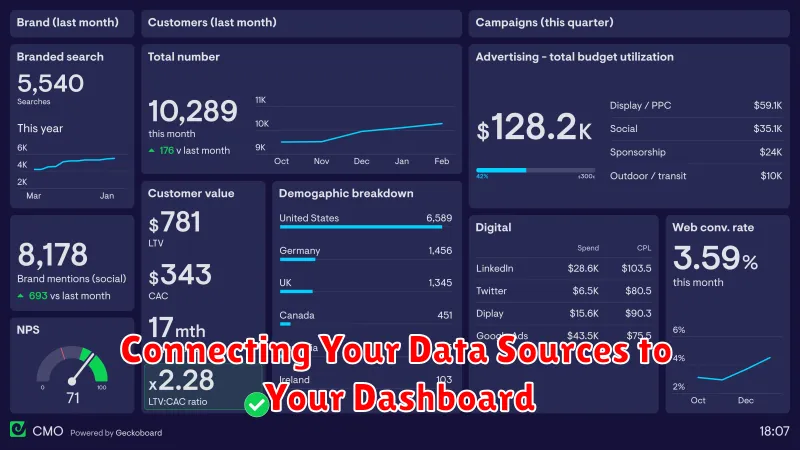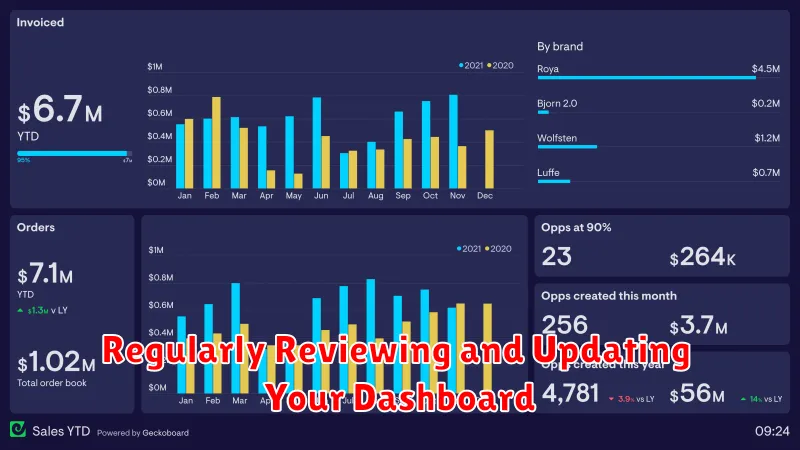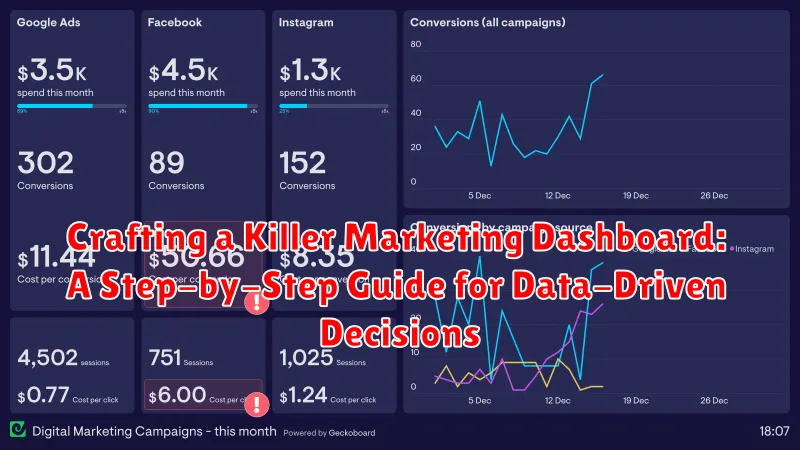In today’s dynamic business landscape, data-driven decision-making is no longer a luxury, but a necessity. A well-crafted marketing dashboard empowers businesses to monitor key performance indicators (KPIs), gain actionable insights, and optimize their marketing strategies for maximum impact. This step-by-step guide will provide you with the knowledge and tools to craft a killer marketing dashboard that transforms raw data into informed decisions, ultimately driving business growth and achieving marketing objectives. Whether you are a seasoned marketing professional or just starting out, this guide will equip you with the essential steps to build a dashboard tailored to your specific needs.
This comprehensive guide covers everything from identifying your crucial marketing KPIs to selecting the right visualization tools and ensuring your dashboard remains dynamic and insightful. Learn how to effectively track website traffic, conversion rates, social media engagement, return on investment (ROI), and other vital metrics. By following this step-by-step guide, you will be able to create a killer marketing dashboard that provides a clear, concise, and actionable view of your marketing performance, enabling you to make data-driven decisions that propel your business forward.
Defining Your Marketing Goals
Before diving into metrics and dashboards, it’s crucial to clearly define your marketing goals. A dashboard without direction is like a ship without a rudder. Establishing concrete, measurable, achievable, relevant, and time-bound (SMART) goals is the first step.
Ask yourself: What are you trying to achieve with your marketing efforts? Are you focused on increasing brand awareness, generating leads, driving sales, or improving customer retention? Each of these objectives requires a different approach and, consequently, different metrics for tracking progress.
For example, if your goal is to increase brand awareness, you might focus on metrics like social media reach and engagement. However, if your primary objective is lead generation, website conversions and lead form submissions become more critical.
Clearly documented goals will serve as the foundation for your dashboard, ensuring that you track the most relevant data and make data-driven decisions that contribute to your overall marketing success. This clarity will help you select the right Key Performance Indicators (KPIs) for accurate performance measurement.
Choosing the Right Metrics for Your Dashboard
Selecting the right metrics is crucial for a truly effective marketing dashboard. The metrics you track should directly reflect your defined marketing goals. Avoid the trap of vanity metrics that look impressive but don’t offer actionable insights. Instead, focus on metrics that provide a clear understanding of your marketing performance and inform strategic decisions.
Consider the following categories of metrics when building your dashboard:
- Website Traffic: Track metrics like unique visitors, page views, bounce rate, and average session duration to understand website engagement and user behavior.
- Lead Generation: Monitor metrics such as conversion rates, cost per lead, and lead quality to assess the effectiveness of your lead generation efforts.
- Sales Performance: Include metrics like customer acquisition cost (CAC), customer lifetime value (CLTV), and sales revenue to measure the impact of marketing on your bottom line.
- Social Media Engagement: Track metrics like follower growth, reach, engagement rate, and sentiment to understand the performance of your social media activities.
By carefully selecting relevant metrics, your dashboard will provide a powerful tool for measuring progress, identifying areas for improvement, and ultimately, achieving your marketing objectives. Remember to prioritize quality over quantity and focus on the metrics that truly matter.
Selecting the Best Dashboard Software for Your Needs
Choosing the right dashboard software is crucial for maximizing the effectiveness of your marketing data. The ideal platform should align with your specific requirements and budget.
Consider these key factors when evaluating different software options:
- Data integration capabilities: Ensure the software can seamlessly connect with your various data sources, such as CRM, analytics platforms, and social media channels.
- Customization options: Look for a platform that allows you to tailor the dashboard to your specific needs, including choosing the metrics, visualizations, and layout.
- User-friendliness: The software should be intuitive and easy to navigate, even for team members who aren’t data experts.
- Reporting and sharing features: Consider whether the platform allows you to easily generate reports, share dashboards with stakeholders, and export data in various formats.
- Pricing and scalability: Choose a solution that fits within your budget and can scale as your data needs grow.
Researching and comparing different options is essential to finding the perfect fit for your marketing team. Don’t hesitate to take advantage of free trials and demos to explore the functionalities of each platform.
Connecting Your Data Sources to Your Dashboard

A crucial step in building an effective marketing dashboard is connecting it to your various data sources. This integration allows your dashboard to pull in real-time data, providing you with the most current insights.
The process usually involves authenticating your data sources with the chosen dashboard software. This might involve providing API keys, login credentials, or granting specific permissions. Security is paramount during this stage, so ensure you understand the security protocols of both your data sources and the dashboard software.
Common marketing data sources include website analytics platforms, CRM systems, social media platforms, email marketing platforms, and advertising platforms. The specific sources you connect will depend on your chosen marketing metrics and overall goals.
Most dashboard solutions offer a range of pre-built integrations, simplifying the connection process. For less common platforms, you may need to use custom integrations or APIs. After connecting, verify the data flow to ensure accurate and consistent reporting.
Customizing Your Dashboard
Once you’ve connected your data sources and populated your dashboard with key metrics, the next crucial step is customization. This is where you tailor the dashboard to perfectly reflect your specific needs and preferences, ensuring it’s as effective as possible.
Start by organizing your dashboard elements in a logical and intuitive manner. Group related metrics together and consider using visual cues, such as color-coding, to highlight key performance indicators (KPIs).
Most dashboard software offers a variety of customization options, such as adjustable widgets, customizable charts, and flexible layouts. Experiment with these features to create a dashboard that is both visually appealing and easy to understand. The goal is to be able to quickly grasp the overall performance of your marketing efforts at a glance.
Consider incorporating interactive elements, like drill-down functionality, to allow for deeper analysis of specific data points. This enables you to explore the underlying factors contributing to your results and gain more granular insights.
Finally, remember that your dashboard should be a dynamic tool. Regularly review and refine its configuration to ensure it continues to meet your evolving needs and remains aligned with your marketing objectives.
Visualizing Your Data with Charts and Graphs
Choosing the right visualization method is crucial for understanding your marketing data. Different charts and graphs excel at showcasing different types of data, allowing you to extract meaningful insights. Consider your data and the story you want to tell when selecting your visualization method. A poorly chosen chart can obscure information and hinder decision-making.
Line charts are excellent for tracking trends over time, such as website traffic or sales growth. Bar charts are effective for comparing different categories, like the performance of various marketing campaigns. Pie charts illustrate the composition of a whole, such as market share distribution. Scatter plots can reveal correlations between two variables, like ad spend and conversions.
Ensure your charts are easy to read and interpret. Use clear labels, appropriate scales, and a consistent color scheme. Avoid cluttering your dashboard with too many visuals. Focus on the key metrics that align with your marketing objectives.
Sharing Your Dashboard with Your Team
A well-crafted marketing dashboard loses its value if not shared effectively. Collaboration is key to leveraging the insights derived from your data. Choosing the right sharing method ensures everyone stays informed and can contribute to data-driven decisions.
Consider these options for sharing your dashboard:
- Scheduled Reports: Automate email delivery of key metrics and visualizations on a daily, weekly, or monthly basis.
- Live Dashboard Access: Provide team members with direct access to the live dashboard, allowing them to explore data independently.
- Presentation Mode: Utilize a presentation mode for showcasing key findings and insights during team meetings.
- Exportable Reports: Allow users to export data and visualizations in various formats (e.g., PDF, CSV) for further analysis or offline viewing.
When sharing, clearly communicate the purpose and key metrics of the dashboard. Offer brief training sessions or documentation to ensure everyone understands how to interpret the data presented.
Remember to establish a consistent sharing schedule to keep your team informed and aligned with marketing performance.
Analyzing Your Data and Making Data-Driven Decisions
A well-constructed marketing dashboard is useless without proper analysis. This stage transforms raw data into actionable insights. Begin by identifying key performance indicators (KPIs) relevant to your marketing objectives. These might include conversion rates, customer acquisition cost (CAC), or return on ad spend (ROAS).
Next, look for trends and patterns in your data. Are certain campaigns outperforming others? Is there a correlation between specific marketing activities and increased leads? Use your dashboard’s visualizations to identify these relationships. Don’t just observe the data; question it. Ask why certain metrics are performing the way they are.
Finally, translate your analysis into concrete actions. For example, if your data reveals a high bounce rate on a particular landing page, investigate the cause. Perhaps the page needs to be redesigned, or the messaging needs to be adjusted. Data analysis should inform and refine your marketing strategies. Regularly review your KPIs and adjust your campaigns accordingly to optimize performance.
Regularly Reviewing and Updating Your Dashboard

A marketing dashboard isn’t a “set it and forget it” tool. To derive continuous value, regular review and updates are crucial. Consistent monitoring ensures your dashboard remains relevant and reflects the current market dynamics.
Establish a review cadence that aligns with your business needs. Weekly or bi-weekly reviews are often effective for capturing short-term trends and making necessary adjustments. Monthly reviews can offer a broader perspective on overall performance.
During reviews, scrutinize the data for significant changes or anomalies. Ask critical questions: Are KPIs trending in the right direction? Are there unexpected fluctuations? Do the metrics accurately reflect campaign performance?
Based on your analysis, update your dashboard. This might involve adjusting KPIs, refining data sources, or modifying visualizations to enhance clarity. A dynamic dashboard that evolves with your marketing strategies is essential for continued success.

